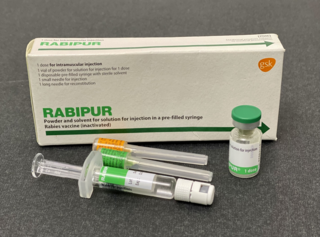Related Research Articles

The Serengeti ecosystem is a geographical region in Africa, spanning the Mara and Arusha Regions of Tanzania. The protected area within the region includes approximately 30,000 km2 (12,000 sq mi) of land, including the Serengeti National Park and several game reserves. The Serengeti hosts the second largest terrestrial mammal migration in the world, which helps secure it as one of the Seven Natural Wonders of Africa.

Canine distemper virus (CDV) is a viral disease that affects a wide variety of mammal families, including domestic and wild species of dogs, coyotes, foxes, pandas, wolves, ferrets, skunks, raccoons, and felines, as well as pinnipeds, some primates, and a variety of other species. CDV does not affect humans.

Ngorongoro Conservation Area is a protected area and a UNESCO World Heritage Site located in Ngorongoro District, 180 km (110 mi) west of Arusha City in Arusha Region, within the Crater Highlands geological area of northern Tanzania. The area is named after Ngorongoro Crater, a large volcanic caldera within the area. The Ngorongoro Conservation Area Authority administers the conservation area, an arm of the Tanzanian government, and its boundaries follow the boundary of the Ngorongoro District in Arusha Region. The western portion of the park abuts the Serengeti National Park, and the area comprising the two parks and Kenya's Maasai Mara game reserve is home to Great Migration, a massive annual migration of millions of wildebeest, zebras, gazelles, and other animals. The conservation area also contains Olduvai Gorge, one of the most important paleoanthropological sites in the world.

An animal bite is a wound, usually a puncture or laceration, caused by the teeth. An animal bite usually results in a break in the skin but also includes contusions from the excessive pressure on body tissue from the bite. The contusions can occur without a break in the skin. Bites can be provoked or unprovoked. Other bite attacks may be apparently unprovoked. Biting is a physical action not only describing an attack but it is a normal response in an animal as it eats, carries objects, softens and prepares food for its young, removes ectoparasites from its body surface, removes plant seeds attached to its fur or hair, scratching itself, and grooming other animals. Animal bites often result in serious infections and mortality. Animal bites not only include injuries from the teeth of reptiles, mammals, but fish, and amphibians. Arthropods can also bite and leave injuries.

A dog bite is a bite upon a person or other animal by a dog, including from a rabid dog. More than one successive bite is often called a dog attack, although dog attacks can include knock-downs and scratches. Though some dog bites do not result in injury, they can result in infection, disfigurement, temporary or permanent disability, or death. Another type of dog bite is the "soft bite" displayed by well-trained dogs, by puppies, and in non-aggressive play. Dog bites can occur during dog fighting, as a response to mistreatment, by trained dogs working as guard, police or military animals, or during a random encounter.

Neglected tropical diseases (NTDs) are a diverse group of tropical infections that are common in low-income populations in developing regions of Africa, Asia, and the Americas. They are caused by a variety of pathogens, such as viruses, bacteria, protozoa, and parasitic worms (helminths). These diseases are contrasted with the "big three" infectious diseases, which generally receive greater treatment and research funding. In sub-Saharan Africa, the effect of neglected tropical diseases as a group is comparable to that of malaria and tuberculosis. NTD co-infection can also make HIV/AIDS and tuberculosis more deadly.

Vaccination of dogs is the practice of animal vaccination applied to dogs. Programs in this field have contributed both to the health of dogs and to the public health. In countries where routine rabies vaccination of dogs is practiced, for example, rabies in humans is reduced to a very rare event.

World Rabies Day is an international awareness campaign coordinated by the Global Alliance for Rabies Control, a non-profit organization with headquarters in the United States. It is a United Nations Observance and has been endorsed by international human and veterinary health organizations such as the World Health Organization, the Pan American Health Organization, the World Organisation for Animal Health and the US Centers for Disease Control and Prevention.

Wild animals, domestic animals and humans share a large and increasing number of infectious diseases, known as zoonoses. The continued globalization of society, human population growth, and associated landscape change further increase the interactions between humans and other animals, thereby facilitating additional infectious disease emergence. Contemporary diseases of zoonotic origin include SARS, Lyme disease and West Nile virus.

The rabies vaccine is a vaccine used to prevent rabies. There are several rabies vaccines available that are both safe and effective. They can be used to prevent rabies before, and, for a period of time, after exposure to the rabies virus, which is commonly caused by a dog bite or a bat bite.

Rabies is a viral disease that causes encephalitis in humans and other mammals. It was historically referred to as hydrophobia due to the symptom of panic when presented with liquids to drink. Early symptoms can include fever and tingling at the site of exposure. These symptoms are followed by one or more of the following symptoms: nausea, vomiting, violent movements, uncontrolled excitement, fear of water, an inability to move parts of the body, confusion, and loss of consciousness. Once symptoms appear, the result is virtually always death, regardless of treatment. The time period between contracting the disease and the start of symptoms is usually one to three months but can vary from less than one week to more than one year. The time depends on the distance the virus must travel along peripheral nerves to reach the central nervous system.
Almost all human deaths caused by rabies occur in Asia and Africa. There are an estimated 59,000 human deaths annually from rabies worldwide.

In animals, rabies is a viral zoonotic neuroinvasive disease which causes inflammation in the brain and is usually fatal. Rabies, caused by the rabies virus, primarily infects mammals. In the laboratory it has been found that birds can be infected, as well as cell cultures from birds, reptiles and insects. The brains of animals with rabies deteriorate. As a result, they tend to behave bizarrely and often aggressively, increasing the chances that they will bite another animal or a person and transmit the disease.

The Global Alliance for Rabies Control (GARC) is a non-profit organization that aims to eliminate deaths from canine rabies by 2030. Rabies is a neglected disease of poverty, which is almost 100% fatal, but can also be prevented with available vaccines. The Global Alliance for Rabies Control's work centers around the One Health Approach where vaccinating dogs stops the disease at its source and protects the whole community. Where the funding and political will exist, canine rabies has been eliminated. Inequality in access to preventive health care and proven control methods means that around 59,000 people, almost all in Africa and Asia, die every year.

Mission Rabies is a charity that was initially founded as an initiative by Worldwide Veterinary Service (WVS), a United Kingdom-based charity group that assists animals. Mission Rabies has a One Health approach driven by research to eliminate dog bite transmitted rabies. Launched in September 2013 with a mission to vaccinate 50,000 dogs against rabies across India, Mission Rabies teams have since then vaccinated 968,287 dogs and educated 2,330,597 children in dog bite prevention in rabies endemic countries.

Sarah Cleaveland is a veterinary surgeon and Professor of Comparative Epidemiology at the University of Glasgow.

Rabies is a viral disease that exists in Haiti and throughout the world. It often causes fatal inflammation of the brain in humans and other mammals, such as dogs and mongooses in Haiti. The term "rabies" is derived from a Latin word that means "to rage"; rabid animals sometimes appear to be angry. Early symptoms can include fever and tingling at the site of exposure, followed by one or more of the following symptoms: violent movements, uncontrolled excitement, fear of water, an inability to move parts of the body, confusion, and loss of consciousness. Once symptoms appear, death is nearly always the outcome. The time period between contracting the disease and showing symptoms is usually one to three months; however, this time period can vary from less than a week to more than a year. The time between contraction and the onset of symptoms is dependent on the distance the virus must travel to reach the central nervous system.
A monkey bite is the bite of a monkey and is the second most common animal bite after dogs in India. Monkey bites account for 2–21% of animal bite injuries. Monkey bites are an important risk among travelers and after dog bites is the most common animal bite for travelers. Treatment depends upon many factors including the suspicion of rabies. Management involves:
Neglected tropical diseases in India are a group of bacterial, parasitic, viral, and fungal infections that are common in low income countries but receive little funding to address them. Neglected tropical diseases are common in India.

Animal vaccination is the immunisation of a domestic, livestock or wild animal. The practice is connected to veterinary medicine. The first animal vaccine invented was for chicken cholera in 1879 by Louis Pasteur. The production of such vaccines encounter issues in relation to the economic difficulties of individuals, the government and companies. Regulation of animal vaccinations is less compared to the regulations of human vaccinations. Vaccines are categorised into conventional and next generation vaccines. Animal vaccines have been found to be the most cost effective and sustainable methods of controlling infectious veterinary diseases. In 2017, the veterinary vaccine industry was valued at US$7 billion and it is predicted to reach US$9 billion in 2024.
References
- ↑ Knobel, Darryn L.; Cleaveland, Sarah; Coleman, Paul G.; Fèvre, Eric M.; Meltzer, Martin I.; Miranda, M. Elizabeth G.; Shaw, Alexandra; Zinsstag, Jakob; Meslin, François-Xavier (2005). "Re-evaluating the burden of rabies in Africa and Asia". Bulletin of the World Health Organization. 83 (5): 360–368. PMC 2626230 . PMID 15976877.
- ↑ Coleman, Paul G.; Fèvre, Eric M.; Cleaveland, Sarah (2004). "Estimating the Public Health Impact of Rabies". Emerging Infectious Diseases. 10 (1): 140–142. doi:10.3201/eid1001.020744. PMC 3322764 . PMID 15078611.
- ↑ Sambo, Maganga; Cleaveland, Sarah; Ferguson, Heather; Lembo, Tiziana; Simon, Cleophas; Urassa, Honorati; Hampson, Katie (7 November 2013). "The Burden of Rabies in Tanzania and Its Impact on Local Communities". PLOS Neglected Tropical Diseases. 7 (11): e2510. doi: 10.1371/journal.pntd.0002510 . PMC 3820724 . PMID 24244767.
- ↑ Cleaveland, Sarah; Fèvre, Eric M.; Kaare, Magai; Coleman, Paul G. (2002). "Estimating human rabies mortality in the United Republic of Tanzania from dog bite injuries". Bulletin of the World Health Organization. 80 (4): 304–310. PMC 2567765 . PMID 12075367.[ clarification needed ]
- ↑ Fitzpatrick, Meagan C.; Hampson, Katie; Cleaveland, Sarah; Meyers, Lauren Ancel; Townsend, Jeffrey P.; Galvani, Alison P.; Reithinger, Richard (21 August 2012). "Potential for Rabies Control through Dog Vaccination in Wildlife-Abundant Communities of Tanzania". PLOS Neglected Tropical Diseases. 6 (8): e1796. doi: 10.1371/journal.pntd.0001796 . PMC 3424251 . PMID 22928056.